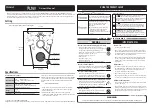
DESIGNER’S HANDBOOK 4189350049C EN
Page 15 of 206
3.1.3
VI-setup profile (VS)
For each VI, at least one VI-setup profile (VS) will be predefined.
The “Virtual Indicator setup” profile is a predefined list of parameters such as:
input settings, data scaling,
selectable headlines, labels, units and more.
Collecting all the vital indicator parameters in a VS profile makes it simple, secure and easy for the installer to
make a complex setup, simply by selecting the right VS.
In the selection menu, each VS has a unique number, name and a detailed help text description that makes the
selection easy.
All input parameters and indicator related output parameters (relay output or NMEA output) are gathered in the
VS profile. The VS profile for the special multi-screen indicator available in the XDi-N version contains input setup
parameters for all screens (up to 4).
Defining several VI-setup profiles is very handy if a virtual indicator is used in different applications, with different
interface requirements, for example presenting data from different propulsion systems with different
combination of CAN and analogue data inputs to the same type of indicator.
It is possible to change or adjust most VS parameters from the XDi installation menu.
It is possible to have up to 50 predefined VS profiles for each virtual indicator.
Note: Only one VI-setup profile can be active at any given time.
3.1.4
Library types
XDi libraries may either be a DEIF standard library, containing a selection of commonly used virtual indicator types.
DEIF standard indicators always include a day- and a night-design optimised for presentation on the XDi display
under all light conditions.
If the DEIF standard design does not fulfil your needs or wants, the XDi concept opens for a flexible pallet of
customisation opportunities from small changes like adding a logo on a standard design, making a customised
interface profile and all the way to a full-customised design fitting perfectly into your
company’s overall product
design line.
DEIF stores all libraries in a secure master database, providing the needed version control and design verification
to secure that indicator designs follow the appropriate regulations. Once an indicator is finally approved as part of a
library, it will be available precisely as approved even years from now when a spare part is needed.
The XDi library may contain up to at least 100 virtual indicators depending on the complexity and number of
day/night colour schemes (or even day/dusk/night schemes).
All XDi libraries are defined by a unique owner identification number (Owner ID). DEIF owner ID for standard
libraries are in the range 000001 to 009999.
The owner ID for a customised library is normally the same as the customer
’s account number at DEIF.
Each library owner may have up to 999 libraries, each identified by a unique number starting from 1.
A customised library is by default only available for use in XDi units purchased by the library owner, and on
request, DEIF can open for sister companies or sub-suppliers to also be able to purchase XDi units with a
customised library.
3.1.5
XDi type and related library classes
There is a library type for product size XDi 96 and XDi 144/192 and for each performance class.
XDi 144 and 192 both have the same display resolution (WVGA) and can therefore use the same library.
XDi 96 has a QVGA display resolution and thus needs its own library.
In addition to product size, the libraries are also classified as:
Single*
, Dual and Multi.
















































